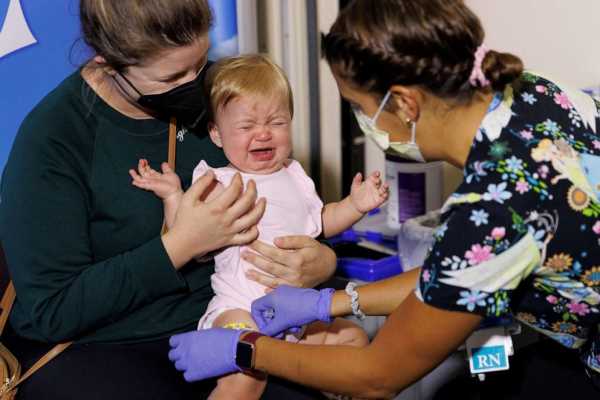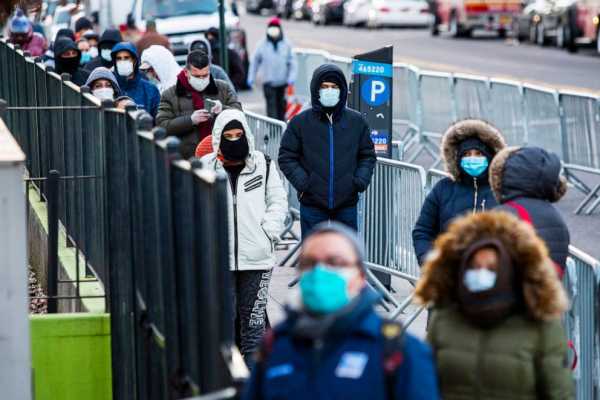As the United States continues to open up, and fewer restrictions and mitigation measures remain in place, it's hard to imagine the early days of the COVID-19 pandemic.
Much has changed from three years ago when workplaces and schools closed, businesses shuttered, and stay-at-home orders were enacted — and even from two years ago when vaccines started rolling out and people began moving around again.
As we move into a new phase where COVID-19 is more endemic, many of these memories will fade with the passage of time and the constraints of how much our brain can hold, but experts say it's more than that.
Neuroscientists and psychiatrists told ABC News that we may also try to forget certain memories to protect ourselves from the trauma that we've been processing over the last three years.
Additionally, as vaccines and boosters become easy to access, reducing the number of hospitalizations and deaths, we may forget a time when more than 700 people a day — in some states — were dying of the virus.
MORE: COVID-19: A look back on where the US succeeded and where we didn’t
"The brain creates these event boundaries when important things happen and so there may be some natural forgetting that's happening because people are putting a boundary between, say, the beginning of COVID and then whenever they consider to be a kind of a post-COVID phase," Dr. Kevin LaBar, a professor of psychology and neuroscience at Duke University, told ABC News.
"And now that we don't have all the same visual reminders — things like masking or social distancing or being on Zoom all the time — so there's kind of a natural way in which the brain compartmentalizes things," he added.
How memories are formed
Different parts of the brain have different duties and responsibilities and, as people go through a variety of experiences, the hippocampus and the cortex play a role in forming memories based on those experiences.
"In any kind of situation, when we're learning new information, it's passing through our cortex," Dr. Sarah Clinton, an associate professor and associate director at the Virginia Tech School of Neuroscience, told ABC News. "Our cortex is what's paying attention to the information. It gets passed to the hippocampus, where it sort of gets sorted and filed."
Over time, the hippocampus files the memory, which Clinton likened to putting a book on a shelf.

STOCK PHOTO/Getty Images
The hippocampus will then also help with recall, "kind of finding that information, pulling it off the shelf, and then you can actually use it," Clinton said.
Protecting ourselves from trauma
Throughout the course of the pandemic, Americans have experienced a variety of traumatic events, whether it's losing a loved one to COVID-19, treating seriously ill patients as a frontline health care worker, or losing a job or a form of income.
Research has shown the pandemic has led to increased rates of anxiety, depression, psychosis, loneliness and other mental health issues.
When somebody is exposed to a traumatic event, there are two ways memories can be suppressed. Some people can bury the memory to forget some or most of what happened while others just work on ways to prevent the memory from coming back to them.
"For most people, when we experience a trauma, the memory is laid down quite effectively, actually," Jennifer Holzhauer, a clinical case manager in the department of psychiatry at Washington University School of Medicine in St. Louis, told ABC News. "And, in fact, the most common symptoms that we have is that we can't forget about it. In fact, most of us want to not have the memories, we call them intrusive thoughts."
She continued, "So a very common response to that is to try to avoid anything that reminds us of what happened, that will make those memories come back again. Many times, people will try to suppress that memory."
Holzhauer said people forgetting traumatic memories is not necessarily a bad thing, but there are healthy ways to go about it versus unhealthy ways.

EMTs rush a patient to the emergency room at Massachusetts General Hospital in Boston, March 24, 2020, as the number of confirmed Massachusetts cases of coronavirus soars to near 5,000.The Boston Globe via Getty Images
Unhealthy methods can include substance abuse, gambling, overeating and increased sexual activity, she said. Healthy methods, on the other hand, can include exercise, connecting with nature and spending time with friends and family who make us feel safe.
Monotony of day-to-day life
Another reason some may be forgetting their pandemic memories, especially from the early days, is due to the monotony of daily life.
In 2020, as jobs and schooling became remote and people limited how much they traveled, day-to-day routines became similar.
Additionally, there was no change in scenery. People were having Zoom catchups with their friends in the same part of their home they were using as an office, making events indistinguishable, experts say.
MORE: Faces of some of the lives lost this year in the COVID-19 crisis
"Memories are updated when there's new information,' said LaBar. "So, if people felt that their day-to-day activities were very similar during the pandemic, then that time period is going to be dealt with in memory is almost like a single event, in a single extended event instead of lots of different events happening."
Clinton agreed and said because people weren't having new experiences, it may have affected the makeup of our brain, and therefore, the ability to form memories.
"Our brain cells, they're very sensitive to the environment," she said. "High levels of stress can make neurons shrink. Well, oftentimes, when we're engaging, we're learning and we're exposed to a new environment, that actually kind of has the opposite effect, it promotes and helps cells to grow."
LaBar added that as the U.S. moves into this new endemic phase with people having more unique experiences, this will help generate new memories.
MORE: Pandemic has affected 'extraordinary' number of children, researcher tells David Muir
Forgetting how dangerous COVID was before vaccines
Infectious disease experts say there is an element of pandemic fatigue after having our lives upended for the last three years and so there is an eagerness to move on.
However, people may also be forgetting how deadly the first couple of years of the pandemic were before vaccines and boosters became readily available and accessible.

Following CDC approval for vaccination of children aged 6 months to 5 years, 10-month-old Hazel Ribnik reacts, as nurse Jillian Mercer administers the Moderna vaccine for the coronavirus disease (COVID-19) at Rady Children’s Hospital in San Diego, June 21, 2022.Mike Blake/Reuters, FILE
For example, this is the first winter the U.S. did not experience a wave.
During the first winter wave of 2020-21, weekly cases peaked at 1,714,256 the week of Jan. 13, 2021, as did weekly deaths at 23,378, according to data from the Centers for Disease Control and Prevention.
By comparison, during winter 2022-23, according to the CDC, the highest number of weekly cases was 472,601 the week of Dec. 7, 2022, while weekly deaths peaked at 4,448 the week of Jan. 11, 2023.
This is similar to many other vaccine-preventable diseases. For example, before the measles vaccine was released in the United States, between 400 to 500 children died of measles and its complications every year.
But because deaths are now so far and few between thanks to vaccines, people have a misconception that measles — and other diseases — are not dangerous rather than realizing vaccines have prevented them from being dangerous.
"It shows that you can get vaccines, and people can forget how bad something can be," Dr. Bill Hanage, an associate professor of epidemiology at Harvard T.H. Chan School of Public Health, told ABC News. "So, people are tending to move on, because of the fact that it's not in the news as much, because it's not as bad as it was."
Who that leaves behind
In the process of forgetting, or trying to forget, about the pandemic, there are some people who may never be able to forget.
Those who lost loved ones or were seriously ill with COVID-19 themselves may always have to live with memory of the pandemic.

People line up to get a test at Elmhurst Hospital due to coronavirus outbreak, March 24, 2020, in Queens, N.Y.Eduardo Munoz Alvarez/Getty Images
There's also those with long COVID, those with ongoing symptoms of COVID lasting three months or longer after first becoming infected.
One of those people is David Speal, 40, from New York City, who contracted COVID-19 in March 2020. He was diagnosed with long COVID after dealing with breathing struggles and a consistently high heart rate.
While Speal has dramatically improved since then, the memories of him being in the hospital three years ago and seriously ill are still very vivid in his mind, as well as what he was left with.
"It's okay to move on, in a sense, because we have to and I've also been able to move forward," Speal told ABC News. "But this is something that's very serious…and it's not something you can just brush it off and say, 'Oh, this didn't affect us in any way.'"
He continued, "I may never be the same person I was before this, and I've accepted that to a degree. And it's just something that we have to be able to begin to accept as well."
MORE: Doctor in COVID battle recalls the heartbreak and hope of early pandemic
Dr. Ruwanthi Titano, a cardiologist at Mount Sinai in New York — who has been one of Speal's doctors – said it's important to not forget about the millions of long COVID patients who are still working on regaining their ability to perform day-to-day activities.
"A large portion of patients who are being affected are basically in the prime of their lives, who are young or middle-aged, were still working," she told ABC News. "These are people we can afford to say, 'Okay, well, all the rest of us are moving on, and good luck.'"
She continued, "While there's a lot of fatigue in the news and even among providers, there's a really significant portion of the population who still need help."
Sourse: abcnews.go.com






